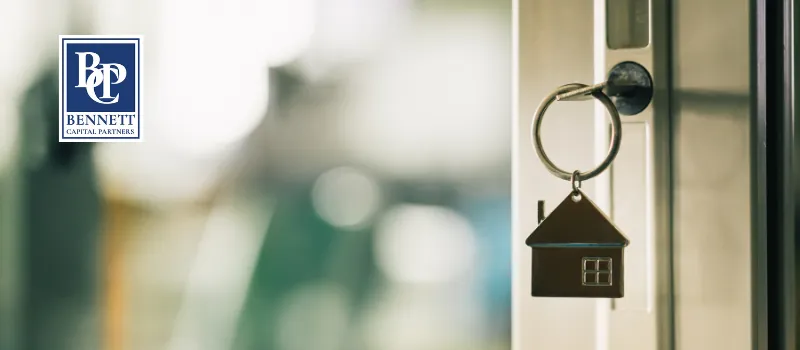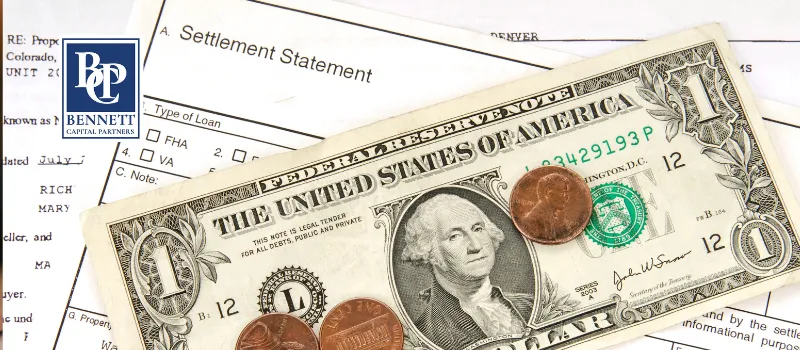Unlock Your Equity with a Home Equity Line Of Credit
Updated: Oct 28, 2023

Looking to unlock the value tied up in your home? You're not alone, many Homeowners find themselves wanting to tap into their home equity. Research shows that a Home Equity Line of Credit (HELOC) might just be the perfect solution for you! This blog will guide you through how HELOC works, its pros and cons, alternatives, common uses & other key details that matter.
Keep reading; financial freedom could be just a few steps away!
Quick Navigation - Click the link below to jump to that section..
Key Takeaways
✔ A Home Equity Line of Credit (HELOC) is a loan that allows homeowners to borrow money against the equity in their homes.
✔ HELOCs have flexible repayment options and generally offer lower interest rates compared to other forms of credit.
✔ However, there are risks involved with a HELOC, such as variable interest rates, interest only payments and the potential risk of foreclosure if payments are not made.
✔ Common uses for a HELOC include funding home improvements or repairs, consolidating debts, paying medical bills, or covering higher education expenses.
What is a Home Equity Line of Credit (HELOC)?

A Home Equity Line of Credit (HELOC) or Home Equity Loan is a type of second mortgage loan that allows homeowners to borrow money against the equity they have built up in their homes.
Definition and explanation
A Home Equity Line of Credit or HELOC is a loan. We use our home as security for this loan. If we can't make payments, the lender might take our home in return. With this type of loan, you're borrowing money against your house's value.
It's a way to get cash if needed, but it comes with risks too because you could lose your home if payments are missed or completely stopped by us. It's important to understand all aspects before going for such an option as some bad people target those who don't know much about these loans and trick them into deals that are not good at all.
How a HELOC works
A Home Equity Line of Credit (HELOC) lets you access cash using your home as a safety net. You can take money out up to a set limit, like using a credit card. The bank sets this limit based on the value of your house and how much you still owe on it.
Your income and credit history also play parts in setting this limit. You only pay interest on the amount borrowed, not the full amount available to you. A HELOC has two stages: draw period which is usually interest only payments and repayment period which requires you to pay principal.
During the draw period, you get money as needed and make small payments, usually interest only. In the repayment period, no more funds can be drawn out and repaying what is owed starts in earnest with larger payments each month. During the repayment period, the loan usually converts to a fully amortized, principal and interest repayment schedule.
Qualification requirements for HELOCs
We can guide you on the path to secure a home equity line of credit. First, you need to know the key things that lenders look for:
✔ Home Equity: You must own a good chunk of your home. Most home equity lenders ask that you have at least 20% equity in your home, while some lenders allow as little as 5-10% equity.
✔ Good Credit Score: A high credit score can help you get better terms on your HELOC. It shows that you pay bills on time.
✔ Low Debt-to-Income Ratio: Your monthly debts should be less than 43% - 50% of your total income. This ratio can vary across lenders, they want to see that you make enough money to manage more debt.
✔ Stable Employment History: Lenders prefer borrowers with a steady job and stable income source.
✔ Appraisal: Your home's value will be checked by an appraisal.
How to pay back a HELOC
To pay back a home equity loan (HELOC), you need to make regular payments over a set period of time. Mortgage Amortization typically includes both the principal amount borrowed and the interest that accrues on the outstanding balance.
It is important to make these payments on time to avoid any late fees or penalties. Unlike other types of loans, HELOCs generally have variable interest rates, which means your monthly payment may vary depending on changes in the interest rate.
You can choose to pay off your HELOC early if you want, but it's always a good idea to check with your lender for any prepayment penalties. Remember, paying back a HELOC requires financial discipline and making consistent payments toward reducing your debt.
Advantages and Disadvantages of a HELOC Loan

HELOC loans offer flexibility and convenience, but they also come with risks. Learn about the pros and cons of a HELOC loan to make an informed decision for your financial needs. Keep reading to understand the potential benefits and drawbacks of this type of loan.
Pros and cons
Home Equity Line of Credit (HELOC) loans have their advantages and disadvantages. Let's take a look at the pros and cons:
✔ Access to funds: With a HELOC, you can borrow against the equity in your home and access the funds when needed.
✔ Flexibility: Unlike a home equity loan, a HELOC gives you a revolving credit line that allows you to borrow multiple times within the draw period.
✔ Lower interest rates: HELOCs often have lower interest rates compared to other forms of credit, such as credit cards or personal loans.
✔ Tax benefits: In some cases, the interest paid on a HELOC may be tax deductible.
✔ Variable interest rates: One downside is that HELOCs usually have variable interest rates. This means your monthly payments could increase if interest rates rise.
✔ Risk of foreclosure: Because your home is used as collateral, there is a risk of losing it if you're unable to repay the loan.
✔ Closing costs: Like any mortgage or loan, there are closing costs associated with getting a HELOC, including appraisal fees and origination fees.
HELOC calculator
To calculate how much you can borrow with a Home Equity Line of Credit (HELOC), you don't necessarily need a specific HELOC calculator. Instead, you'll want to determine your home's current value and subtract any outstanding mortgage balance.
This will give you an estimate of your available equity, which is the maximum amount you can borrow with a HELOC. Keep in mind that lenders typically have their own formulas for calculating loan-to-value ratios and credit limits.
It's also important to consider factors like your income, credit score, and debt-to-income ratio when determining your borrowing ability. Remember to consult with different lenders to get personalized information on what you can borrow before making any decisions about a HELOC.
Home Equity Line of Credit Example
Let's say you have a house worth $300,000 and you still owe $200,000 on your mortgage. You may be eligible for a home equity line of credit (HELOC) based on the difference between your home's value and what you owe.
In this example, your available equity would be $100,000 ($300,000 - $200,000). With a HELOC, you can access a portion of that equity to use for things like home improvements or consolidating debt.
Let's say you decide to take out a HELOC with a credit limit of $50,000. During the draw period (typically 5-10 years), you can borrow from that line of credit as needed. For example, if you need $20,000 for kitchen renovations, you can withdraw that amount from your HELOC and start making payments on just the amount borrowed instead of the full credit limit.
It's important to remember that interest is only charged on the amount borrowed and not on the entire available credit limit. As with any loan or line of credit secured by your home’s equity, it’s crucial to carefully consider whether borrowing against your property is in your best interest and assess how comfortably new payments fit into personal finances.
Expected HELOC rates
The expected rates for a home equity line of credit (HELOC) can vary depending on factors such as your income, credit history, and the current market value of your home. Unlike a fixed-rate mortgage, HELOCs typically have variable interest rates that can change over time.
It's important to keep in mind that these rates can fluctuate with market conditions and may increase or decrease during the life of the loan. When considering a HELOC, it's recommended to shop around and compare offers from different lenders to find the best deal for you.
Home Equity Lines of Credit are usually tied to the Fed Funds Prime Rate.
Remember, understanding how interest rates work is essential when evaluating potential monthly payments and overall costs associated with a HELOC.
Common Uses for a HELOC

Homeowners often use a HELOC to fund home improvements or repairs, consolidate existing debts, pay off medical bills, or cover higher education expenses.
Home improvements or repairs
Using a home equity line of credit (HELOC) is a common way people finance home improvements or repairs. With a HELOC, you can borrow against the equity in your home to fund renovations, upgrades, or necessary repairs.
The amount you can borrow and the interest rate will depend on factors like your income, credit history, and the market value of your home. It's important to shop around and compare terms from different lenders to find the best deal for financing your home improvements or repairs.
Remember that using your home as collateral means taking on additional debt and should be done responsibly.
Debt consolidation
One common use for a home equity line of credit (HELOC) is debt consolidation. Homeowners can utilize their home's equity to pay off high-interest debts, such as credit cards or personal loans.
By consolidating these debts into a single HELOC loan, borrowers may benefit from lower interest rates and potentially save money on monthly payments. However, it is essential to carefully consider the risks involved in using your home as collateral and ensure that you can comfortably make the new loan payments.
Working with Bennett Capital partners will ensure you find the best solution for debt consolidation needs while considering the long-term financial impact.
Medical bill payment
If you have medical bills to pay, a Home Equity Line of Credit (HELOC) can be an option to consider. With a HELOC, you can use the equity in your home to borrow money for medical expenses.
This means that you can get access to funds at potentially lower interest rates compared to other forms of borrowing. However, it's important to remember that using your home as collateral carries risks, including the potential loss of your home if you're unable to repay the loan.
Be sure to speak to a loan officer at Bennett Capital Partners before making any decisions about using a HELOC for medical bill payment.
Higher education expenses
Paying for higher education can be a major expense, but a HELOC can provide a flexible and affordable option. With a home equity line of credit, you can borrow against the value of your home to cover tuition fees, textbooks, and other educational costs.
This means you don't have to rely solely on student loans or high-interest personal loans. Plus, the interest rates on a HELOC are often lower than other forms of borrowing. Just remember that using your home as collateral comes with risks, so it's important to carefully consider your options and make sure you can comfortably repay the loan.
Alternatives to a HELOC

If a home equity line of credit doesn't meet your needs, there are other options to consider. One alternative is a cash-out refinance, where you take out a new mortgage for more than you owe on your current one and receive the difference in cash.
Another option is a home equity loan, where you borrow a lump sum of money against the equity in your home and make fixed monthly payments over a set term. These alternatives have their own advantages and disadvantages, so it's important to carefully weigh your options before making a decision.
Cash-out refinance
Cash-out refinance is another option for homeowners to access the equity in their homes. With a cash-out refinance, you can borrow money by refinancing your mortgage for more than what you currently owe.
This allows you to receive the difference in cash, which can be used for various purposes like paying off debt or making home improvements. However, it's important to note that cash-out refinance involves risks, as it increases your mortgage balance and puts your home at risk if you're unable to make the payments.
It's crucial to work with Bennett Capital Partners and carefully consider all factors before opting for a cash-out refinance.
Home equity loans
Home equity loans are a popular alternative to a HELOC. These loans, also called second mortgages, have a fixed interest rate and must be paid back over a set period of time. The amount you can borrow and the interest rate depend on factors like your income, credit history, and the value of your home.
It's important to shop around for the best terms when considering a home equity loan. This type of loan uses the equity in your home as collateral and often offers competitive interest rates. Bennett Capital Partners works with dozens of banks and lenders that offer Home Equity Lines of Credit.
Differences between a home equity loan and a HELOC
Home equity loans and HELOCs are both ways to tap into the value of your home, but they have some key differences. With a home equity loan, you receive a lump sum of cash with a fixed interest rate.
You'll make fixed monthly payments over a set repayment period. On the other hand, HELOCs are like credit cards, where you can borrow money as needed up to a certain limit during the "draw period." HELOCs typically have variable interest rates.
Another difference is that home equity loans usually come with various fees like closing costs, origination fees, and appraisal fees, while HELOCs often have few or no upfront costs.
How home equity works
When you own a home, you build up something called "home equity." Home equity is the value of your home minus any outstanding mortgage or loans on it. So, if your home is worth $300,000 and you still owe $200,000 on your mortgage, then you have $100,000 in home equity.
This is an important asset that you can use to secure financing, like a home equity line of credit (HELOC) or a home equity loan.
With a HELOC, you're able to borrow against the value of your home while still being able to live in it. It works like a credit card: the lender approves you for an amount based on your home's value and other factors such as income and credit history.
You can access this money whenever you need it by simply writing a check or using a special debit card provided by the lender.
The big advantage of a HELOC is flexibility.
You can use the money as needed and only pay interest on the amount you've borrowed. Also, there are usually two periods: A draw period during which time funds are available to be borrowed; followed by repayment periods during which minimum monthly payments must be made.
During the draw period which typically lasts 5-10 years -the interest rate may be fixed or variable.
However keep in mind two things about borrowing against your house with either type of loan:
Early payment of a HELOC
Paying off a Home Equity Line of Credit (HELOC) before the agreed-upon time can have serious consequences. If you pay it back too soon, the lender may take your home as payment for the debt.
This is because when you use your home as collateral for borrowing money, there's always a risk of potentially losing your property and equity. So, it's important to carefully consider your financial situation and make sure you can comfortably repay the amount borrowed before taking out a HELOC.
Make sure to thoroughly review all terms and conditions with an expert at Bennett Capital Partners before making any decisions.
Closing process timeline
The closing process for a Home Equity Line of Credit (HELOC) can take several weeks. Here is a timeline of the steps involved:
✔ Application: Start by filling out an application with a lender. Provide necessary documents, such as income verification and credit history.
✔ Underwriting: The lender will review your application and supporting documents to determine if you qualify for a HELOC.
✔ Appraisal: An appraisal will be conducted to assess the value of your home. This helps the lender determine the amount of equity you have available.
✔ Approval: Once your application is approved, the lender will provide you with a formal offer letter outlining the terms of the HELOC.
✔ Closing Disclosure: You will receive a Closing Disclosure document that details all costs associated with the loan, including interest rates, fees, and payment terms.
✔ Review and Signing: Take time to carefully review the Closing Disclosure before signing it. Make sure you understand all the terms and conditions.
✔ Funding: After signing, there may be a waiting period before funds are disbursed to you. This can range from a few days to a couple of weeks.
✔ Activation: Once funds are available, you can start using your HELOC by accessing them through checks or a debit card provided by the lender.
Difference between a HELOC and a home improvement loan
A HELOC and a home improvement loan are two different types of borrowing options for homeowners. Firstly, a HELOC is like having a credit card secured by your home's equity. It allows you to borrow money as needed during a draw period, similar to withdrawing cash from an account.
On the other hand, a home improvement loan provides you with a lump sum upfront that you can use specifically for making renovations or repairs to your home. A home equity loan is somewhat like bridge financing but secured as a second lien on the subject property. While both options have their advantages and disadvantages, it's important to understand how they work and consider factors such as interest rates and repayment terms before deciding which option is best for your needs.
Comparison between HELOC and other loan options

When comparing a HELOC to other loan options such as home equity loans or cash-out refinances, it is important to consider factors like interest rates, repayment terms, and access to funds.
Home equity loans typically have fixed interest rates and require fixed monthly payments, whereas a HELOC often has variable interest rates and allows for more flexibility in payment options.
Cash-out refinances involve replacing your existing mortgage with a new one that includes the additional amount you want to borrow, while a HELOC allows you to access funds without impacting your primary mortgage.
Ultimately, the best option depends on individual financial needs and goals.
Home equity loans vs. HELOCs
One common question we often get from mortgage customers is the difference between a Home Equity Loan and a Home Equity Line of Credit (HELOC). Both are types of loans that use your home as collateral, but they have some key differences. Here, we’ll provide a comparison of these loan options to help you make the best choice for your financial situation.
As you can see, both home equity loans and HELOCs have distinct advantages and disadvantages. Your choice should depend on your specific needs and financial situation.
Cash-out refinance vs. HELOCs
When deciding between a cash-out refinance and a home equity line of credit (HELOC), understanding the differences can help you determine the best choice for your situation.
Remember, it's important to consider your financial needs, your ability to repay, interest rates, and terms before deciding between a cash-out refinance and a HELOC. Always consult with a financial advisor or speak with multiple lenders to ensure you're making the best decision for your unique situation.
HELOC vs. personal loan
Borrowing money from lenders comes in many forms and understanding these options allows you to make an informed decision. In our focus today, we will compare a Home Equity Line of Credit (HELOC) to a personal loan.
As you can see, both HELOCs and personal loans have their advantages and disadvantages. The choice between the two will depend on your individual financial situation, risk tolerance, and goals. Always ensure to compare terms when shopping for a loan.
How to Get a HELOC

To get a HELOC, you need to follow a few steps. First, gather all the required documents such as proof of income, bank statements, and employment history. Next, research and compare different HELOC lenders to find the best offer for your needs.
Then, apply for the HELOC with the chosen lender and submit all necessary paperwork. Finally, review the offers received from lenders and choose the one that suits you best. Once everything is finalized, you can close on your HELOC loan and gain access to your line of credit.
Steps to follow
To get a home equity line of credit (HELOC), there are some important steps to follow:
✔ Assess your financial situation and determine if a HELOC is the right choice for you. Consider factors such as your income, expenses, credit score, and how much equity you have in your home.
✔ Research and compare HELOC lenders. Look for reputable lenders with competitive interest rates and favorable terms.
✔ Gather the required documents, which may include proof of income, bank statements, tax returns, and property information.
✔ Apply to multiple lenders to increase your chances of approval and find the best terms for your situation.
✔ Review the offers from different lenders and carefully read all loan documents before signing anything. Pay attention to interest rates, repayment periods, fees, and any potential penalties or restrictions.
✔ Once you've chosen a lender, complete the application process by providing any additional documentation requested.
✔ If approved for a HELOC, go through the closing process with your lender. This typically involves signing legal documents and paying any upfront costs or fees.
✔ After closing on your HELOC, you can start using the funds as needed within your credit limit. Remember that you only pay interest on the amount you borrow.
✔ Make timely payments on your HELOC each month to avoid late fees or negative impacts on your credit score.
✔ Periodically review your HELOC terms and assess if it still meets your needs or if refinancing could be beneficial.
Applying for HELOC and Other Mortgage Solutions with Bennett Capital Partners
At Bennett Capital Partners, we specialize in providing innovative and flexible financing solutions, including HELOCs (Home Equity Lines of Credit), cash-out refinances, and more. Our experienced professionals are dedicated to understanding your unique needs and helping you find the best financing options.
Here's how you can get started with us:
Quick Quote: Not sure what you need? Fill out our Quick Quote form to get an instant estimate tailored to your situation.
Preapproval Request: Ready to take the next step? Submit a Preapproval Request to find out what you qualify for.
Full Application: Know exactly what you want? Start a Full Application right away and let us guide you through the process.
We pride ourselves on our quick turnaround times and competitive rates. Our team will review your application, considering factors like your credit score, debt-to-income ratio, and the amount of equity in your home, to provide you with the best possible solutions.
Whether you're looking to consolidate debt, improve your home, or explore ongoing expenses, Bennett Capital Partners is committed to helping you achieve your goals. Learn more about us and how we can assist you in navigating the mortgage process.
Contact us today to discover how Bennett Capital Partners can make your homeownership or investment property dreams a reality!
Comparing offers and closing on a HELOC
When comparing offers for a home equity line of credit (HELOC), it's important to work with an experienced mortgage brokerage company like Bennett Capital Partners. Look at the annual percentage rate (APR), which includes both the interest rate and any fees, to get an accurate comparison.
Consider factors like balloon payments, prepayment penalties, credit insurance, and your credit score when evaluating offers. Once you've chosen a lender, carefully read through the loan closing papers and make sure you understand all the terms before signing.
Remember that you have three business days under the Three-Day Cancellation Rule to reconsider and cancel the agreement without penalty. HELOCs are protected by federal law, so be aware of disclosure requirements and your right to cancel within three business days.
Home Equity and HELOC Pros and Cons

When considering a home equity line of credit (HELOC), it's important to weigh the pros and cons. One advantage is that a HELOC allows you to access funds as needed, giving you flexibility in how you use the money.
Another benefit is that the interest rates on HELOCs are often lower than credit cards or personal loans. Additionally, some of the interest paid on a HELOC may be tax deductible.
However, there are also downsides to consider. One disadvantage is that using your home as collateral means there's a risk of losing your home if you can't make the payments. Also, unlike a fixed-rate loan, HELOCs often have variable interest rates that can increase over time.
It's also worth noting that some lenders charge fees for opening and maintaining a HELOC.
Overall, while a HELOC can offer financial flexibility and potentially lower interest rates, it's important to carefully consider both the advantages and disadvantages before deciding if it's the right option for you.
Conclusion

In conclusion, a Home Equity Line of Credit (HELOC) can be a valuable tool for homeowners looking to tap into their home's equity. It allows you to borrow money based on the value of your home and use it for various purposes like home improvements or debt consolidation.
However, it is important to carefully consider the risks involved and shop around for the best terms before making this financial decision. Always remember to repay the borrowed amount responsibly to avoid any potential consequences.
FAQs
What is a Home Equity Line Of Credit (HELOC)?
A Home Equity Line Of Credit (HELOC) is a type of loan that allows homeowners to borrow money against the value of their home.
How does a Home Equity Line Of Credit work?
A Home Equity Line Of Credit works by using your home as collateral. You can access funds up to a certain limit, and you only need to pay interest on the amount you borrow.
What can I use a Home Equity Line Of Credit for?
You can use a Home Equity Line Of Credit for various purposes such as home renovations, debt consolidation, education expenses, or emergency expenses.
Are there any risks associated with a Home Equity Line Of Credit?
Yes, there are risks associated with a Home Equity Line Of Credit. If you fail to make payments on time, you may risk losing your home as it serves as collateral for the loan. It's important to borrow responsibly and manage your finances wisely.

Philip Bennett
Philip is the owner and Licensed Mortgage Broker at Bennett Capital Partners, Bus. NMLS # 2046828. He earned his degree in Accounting and Finance from Binghamton University and holds a Master's Degree in Finance from NOVA Southeastern University. With more than 20 years of experience, Philip has been a leader in the mortgage industry. He has personally originated over $2 billion in residential and commercial mortgages.
Learn more about Philip Bennett's background and experience on our Founder's page. Whether you're a first-time homebuyer or a seasoned real estate investor, our team is here to help you achieve your real estate goals. Don't wait any longer, contact us today and let us help you find the right mortgage for your needs.
Discover helpful tips and tricks on mortgages by reading our blog posts
The Ultimate Guide To Hard Money Mortgage Lenders: What You Need To Know about Hard Money Mortgage lenders and how to secure the best financing. Click here to read the full article
